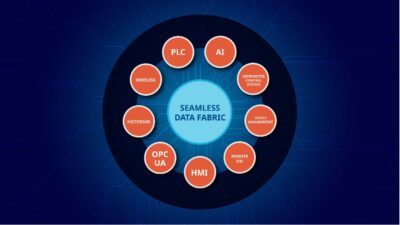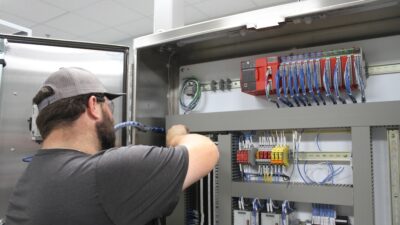In an October 12, 2023 webcast, “SCADA series: Advanced SCADA applications,” Andreina Lugo, software automation manager at Northwind Technical Services, and Mike Lennon, vice president at Applied Control Engineering, discussed the SCADA software selection process and SCADA implementation best practices. Read part 1 of the transcript below.

SCADA insights
- In an October 12, 2023 webcast, “SCADA series: Advanced SCADA applications,” Andreina Lugo, software automation manager at Northwind Technical Services, and Mike Lennon, vice president at Applied Control Engineering, discussed the SCADA software selection process and SCADA implementation best practices.
- In Part 1, Lugo discusses the SCADA software selection process and vendor research.
- Read part 2 for more information on the role and value of system integrators, part 3 for SCADA best practices and part 4 for upcoming advances in SCADA technology.
For an industrial company, selecting a supervisory control and data acquisition (SCADA) system is vital decision that involves taking a variety of different factors into consideration. End-users most find a platform that is compatible with their pre-existing software and hardware; capable of accommodating the needs of their unique applications; allows for future scalability via easy expansion and upgrades; and provides appropriate report configuration and data sharing capabilities. Moreover, once a platform is selected, adhering to best practices is critical to ensuring that end-users get the most out of their chosen software.
In an October 12 Control Engineering webcast, “SCADA series: Advanced SCADA applications,” Andreina Lugo, software automation manager at Northwind Technical Services, and Mike Lennon, vice president at Applied Control Engineering, discussed the SCADA software selection process and SCADA implementation best practices.
Below, the transcript of their presentation has been provided with minor edits and adaptations.
Understanding the SCADA software selection process
Andreina Lugo: A key question is why we need a selection process instead of using the same SCADA software and becoming experts in it. The answer is quite straightforward: every industrial process and customer requirement is unique, often varying in scale and complexity. This diversity necessitates thorough research to understand specific customer needs and requirements before selecting the most suitable SCADA software.
Key steps in the selection process
In the selection process, the initial and most crucial step is to fully understand the industrial process, evaluating its needs and requirements. This step is essential as the information gathered during this research helps in determining the most appropriate SCADA software for the application. A comprehensive understanding of customer needs and requirements is imperative. If these are extensive and vital for the application, choosing suitable SCADA software becomes more challenging. On the other hand, a lack of in-depth research might lead to a seemingly simple initial selection, but later, it may become apparent that the software lacks certain capabilities and features desired by the customer.
Preliminary research recommendations
Before commencing the research, it is recommended to evaluate the industrial process and its operations in detail. Engaging with maintenance personnel and operators to gain a deep understanding of the process and its primary objectives is beneficial. Determining the main goal of the SCADA software and how the customer wishes to view and analyze data are also critical considerations during this research phase.
Five key research considerations for SCADA software selection
In this segment, I would like to outline several critical bullet points which serve as key talking points during the research phase of SCADA software selection.
-
Compatibility assessment. The first point to consider is compatibility. It is essential to investigate the customer’s existing SCADA hardware and software to ensure that the selected software is compatible with their existing controls. This investigation might involve examining legacy controls that may not support current communication protocols, such as OPC, or checking the versions of any SCADA software already implemented in the plant to avoid future compatibility issues.
-
Evaluating system requirements. The next aspect to consider is the number of tags, screens, or clients required by the client. Some clients might have specific minimum requirements for these elements, which can significantly impact pricing. When accommodating these needs, it’s also important to plan for future expansion by allowing for more tags and screens.
-
Functionality and integration needs. Another crucial point is the functionality of the SCADA software. It should accommodate the application’s unique needs. This might involve discussing with the customer whether there is a need to integrate Manufacturing Execution Systems (MES) with the SCADA software, or the necessity to connect to third-party controllers or programs. Other considerations include whether the software should be cloud-based, if data storage on a server is required, and if there’s a need for a mobile device application. Additionally, understanding the customer’s preferences for report viewing, such as custom reports, and requirements for alarms, security, and programming language, is vital.
-
Future expandability. Future expandability is another key factor. The chosen software’s architecture should be robust enough to accommodate growth, allowing for easy expansion and upgrades.
-
Report configuration and data sharing. The final point to consider is report configuration and data sharing. Questions to ponder include whether the customer needs custom reports, prefers cloud-based solutions, or requires the SCADA software to send emails to specific individuals, such as managers, with detailed information, trends, and reports from the SCADA system. Identifying these needs early in the selection process is crucial to avoid challenges in meeting these requirements later.
Importance of thorough research and clear communication
To conclude, the primary focus should be on conducting thorough research and maintaining clear communication with the customer. Understanding the customer’s needs, requirements, and any existing issues is essential. Engaging with maintenance personnel and operators, who are the primary users of SCADA software, to identify their challenges and improvement needs is a critical part of this process.
Researching vendors and their offerings
Now, having established a clear understanding of your customer’s or company’s needs and requirements, the next step involves researching various vendors. This research should focus on exploring the features, capabilities, and costs of the options available. An important aspect of this selection process is to choose a vendor with a solid reputation and a longstanding presence in the market. Opting for a vendor with a risk of disappearing in the near future can lead to issues such as lack of ongoing support, training, or software improvements.
Considering support and training needs
Additionally, the consideration of support and training is crucial. Ensure that the vendor you select can provide the necessary support and training required for your specific needs.
Evaluating options carefully
The third step is a careful evaluation of all options. After comprehensive research, it’s time to select the SCADA software that best fits the identified needs, requirements, and the analysis conducted previously. You may feel confident in your selection at this point. However, I recommend adding a fourth step, especially if the software is unfamiliar.
Testing the selected SCADA software
This fourth step is testing the selected SCADA software. If you are well-acquainted with the software, testing might not be essential. However, if it is new to you, but you believe it is the best choice, testing is strongly advised. If direct testing is not feasible, ensure to ask detailed questions or request a demo from the vendor to confirm that the SCADA software meets all the necessary requirements.


